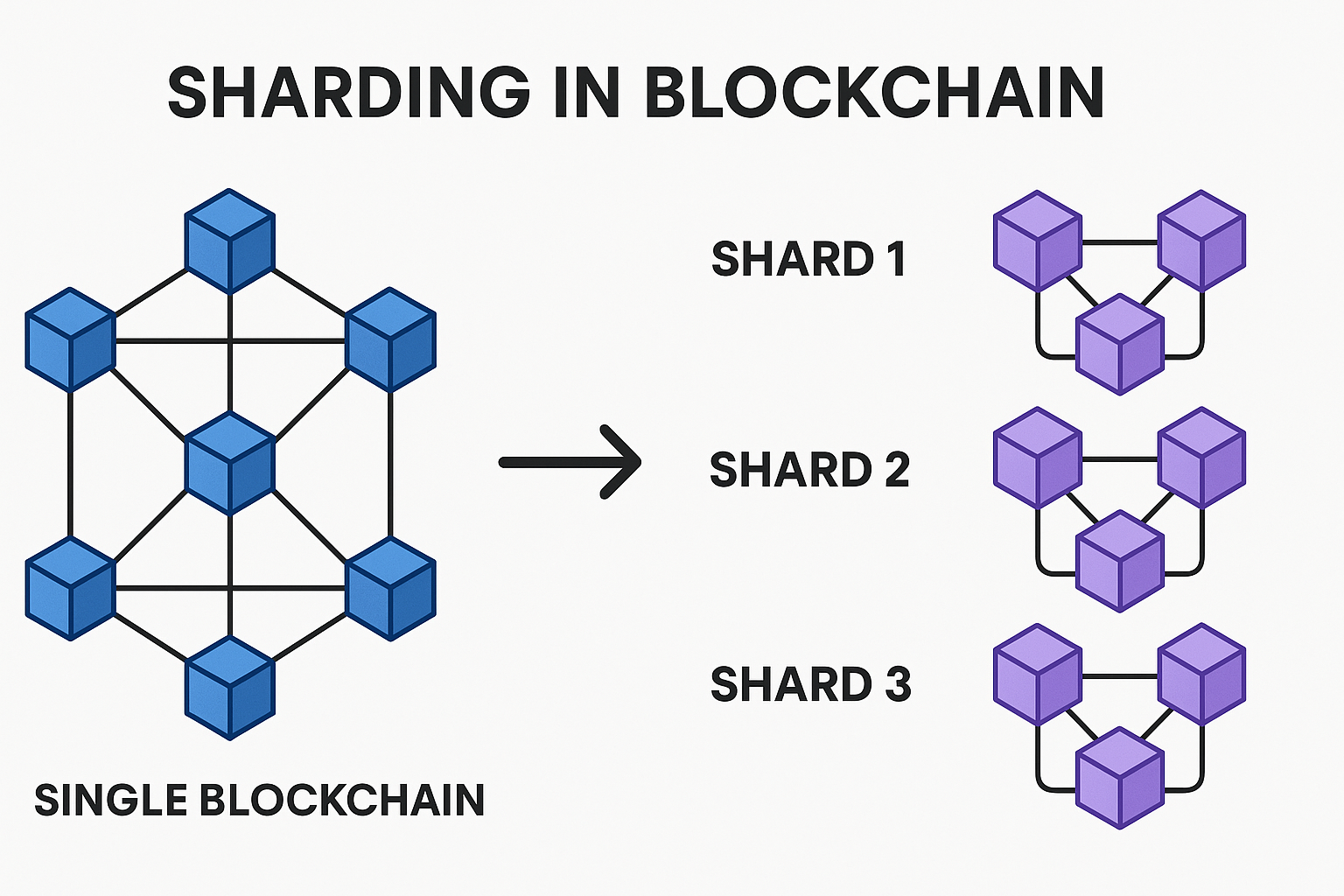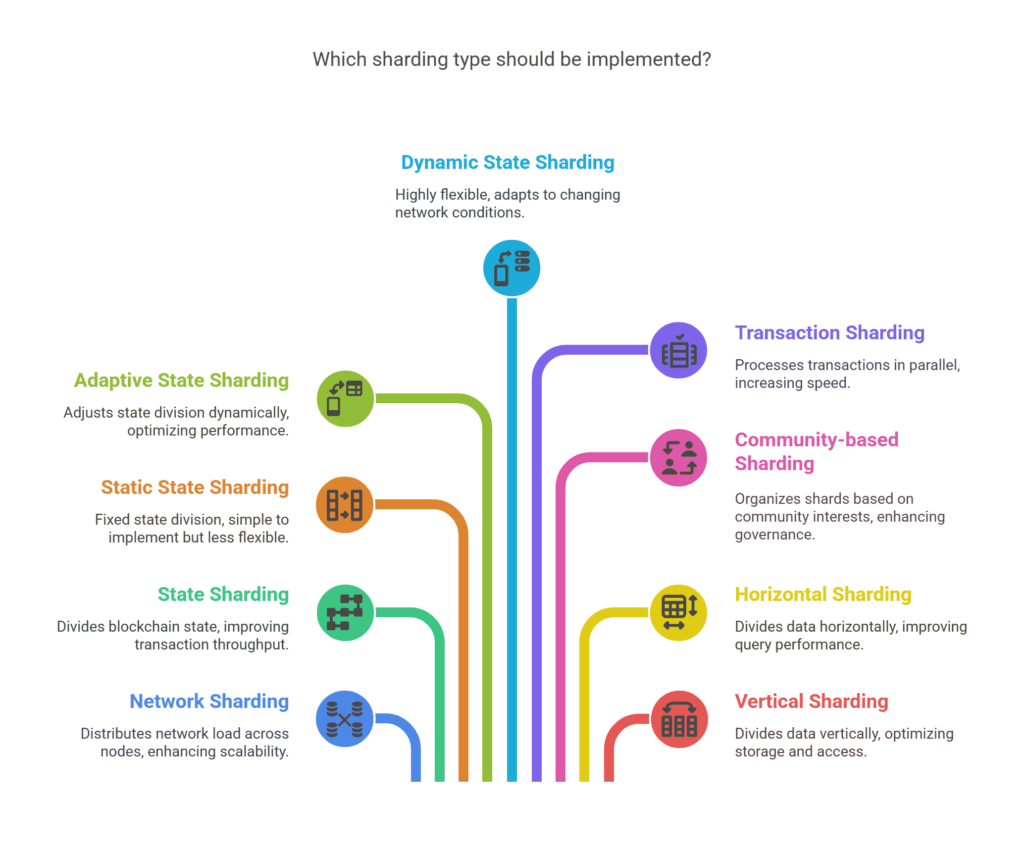What is Sharding in blockchain?

Sharding separates a blockchain network into smaller, independent parts called shards to improve scalability and performance. This method separates network processing and storage by processing transactions in parallel.
Definition:
Sharding breaks a P2P network into shards. The word “shard” denotes “small part of a whole,” like how massive datasets are fragmented for speedier processing.
Purpose:
Sharding in blockchain technology addresses scalability and latency issues. Because each node handles transactions, Ethereum and Bitcoin fail to support complex decentralised programs. This results in congestion and poor transaction times. Sharding seeks to resolve the conundrum of obtaining scalability, security, and decentralisation all at once.
How Sharding Works
Although it is a complicated procedure, sharding a blockchain network essentially entails:
- Shard division: A blockchain network is divided into several smaller chains, called shards. A fraction of the network’s data and transactions are managed by each shard.
- Parallel Processing: Parallel execution is made possible by each shard processing its own transactions and smart contracts separately. This implies that a lot more transactions can be handled at once.
- Sharded networks reduce node burden by only storing and processing data for their shard. Even if nodes only store shard-specific information, sharing information supports decentralisation.
- A coordination layer (sometimes called a “main chain” or “beacon chain”) ensures that all shard chains communicate. This layer checks and adds shard-submitted blocks to its records to support cross-shard communication and network integrity.
Advantages of Sharding
For blockchain networks, sharding has the following benefits:
Scalability
By allowing parallel transaction processing and dividing the burden, it directly tackles the scalability issues of conventional blockchains. By expanding the number of shards, it enables the cumulative transaction throughput to increase as more nodes join the network.
Improved Throughput
Sharding can greatly boost a network’s capacity to execute transactions per second (TPS) by dividing up the processing of transactions among several shards. For example, Ethereum wants to use sharding to reach hundreds of thousands of TPS, but it now manages roughly 10-15 TPS.
Faster Transaction Speeds
Since each shard is not overloaded with the data and transactions of the entire network, it is able to execute transactions more rapidly. Additionally, compared to traditional chains, validators can execute transactions far more quickly.
Decreased Storage Requirements
Individual nodes’ total storage needs are decreased because they only need to store data pertaining to their particular shard. More users can operate complete nodes more easily as a result, preserving decentralisation.
Increased Efficiency
By enabling components to operate in parallel, sharding increases system efficiency for networks handling big content files or lengthy transaction histories.
Sharding Types

Network Sharding
One kind of sharded blockchain that promotes improved node-to-node connectivity is network sharding. This indicates that transactions are processed by the shards while they are appropriately synchronised. Although consensus is carried out on each shard while transactions are processed in parallel, nodes continue to keep a local copy of the entire ledger. It increases the throughput of the ledger, but it encounters the common issue of vertical scaling over time, where the network’s operational costs remain high, leading to rising petrol prices after the maximum throughput is throttled. It should be mentioned that a bad actor’s sybil attack rises with vertical scaling.
State Sharding
Until recently, the state-sharded blockchain was thought to be the most difficult of all the sharded blockchain kinds. So let’s take a moment to comprehend it. In this case, the entire state is separated into many shards. Compared to network sharding, it aids in making transaction processing and verification quicker, safer, and more accurate. In summary, state sharding lowers the storage burden for node operators while facilitating far more effective use of network resources. Higher scalability and affordable bandwidth requirements are generally made possible via state sharding.
Static State Sharding
The state is partitioned in a predetermined, static way that does not change over time. It is easier to implement, but because resources cannot adapt to network conditions, its scalability and efficiency are constrained.
Adaptive State Sharding
Adaptive state sharding adjusts shard size and number based on network characteristics like nodes and data volume. This enables simultaneous transaction execution to manage higher demands during times of high traffic.
Dynamic State Sharding
The most sophisticated kind of sharding is called dynamic state sharding, in which validator nodes are given dynamic address ranges that significantly overlap across several shards. It ensures atomic and cross-shard composability by enabling the simultaneous/parallel processing of transactions impacting multiple shards when paired with transaction-level consensus. True linear scalability is made possible by its proactive load distribution based on past and present network conditions, which causes throughput to rise instantly with each additional node.
Alos Read About Blockchain Performance Metrics, Scalability & Optimization
Transaction Sharding
By dividing the transactions into shards, transaction sharding helps to increase transaction speeds within the same shard. While the address structure is dispersed, the ledger is kept in every node.
Community-based Sharding
Nodes that interact frequently are grouped into a single shard using community-based sharding.
Horizontal Sharding
In order to implement blockchain sharding, bigger databases are divided into smaller ones based on their rows and columns. In a similar manner, bigger data tables are divided into smaller ones and appended to tables that have been sharded. Horizontal sharding occurs when each newly added table has the same schema but each row is distinct. To boost processing speed, distribute the load, and handle more traffic, more machines are added to the current stack.
Vertical Sharding
Vertical sharding involves adding a distinct schema to every new table, in contrast to horizontal sharding. The old schema is faithfully subdivided by this modified one. When a query returns only a portion of the data’s columns, vertical sharding is used.
Also Read About What is Corda blockchain? And Corda Blockchain Architecture
